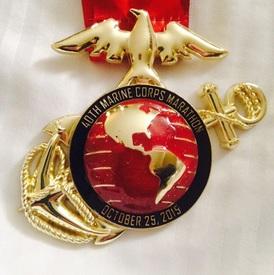I know my BMR, what do I do next?

acceann
Posts: 9 Member
I calculated my BMR with several different calculators, (MFP included) and it's 1490. Is this how many calories I need to eat per day?
0
Replies
-
No, that is what you would need to maintain your current weight if you stayed in bed all day.0
-
Now you input all your data in MFP and it will give you a number of calories you eat to lose. You will earn more by exercising.
Alternately you can figure out your TDEE and subtract 20% and NOT include exercise calories, as TDEE already includes them.
Edited for blondness.0 -
The default stat we usually talk about here is TDEE.
0 -
BMR does not equal maintenance and is not a terribly important number. It is the number of calories you would burn if you were totally inactive--never even left your bed. The simplest way to start is to let MFP set your calories.0
-
Last question, So MFP says I should be eating 1350 calories, I went onto a TDEE calculator and it says my TDEE is 1800. So do I eat 1800 to lose weight? Or do I eat 1350 to lose weight? Sorry for being confusing, just trying to figure this out.0
-
Last question, So MFP says I should be eating 1350 calories, I went onto a TDEE calculator and it says my TDEE is 1800. So do I eat 1800 to lose weight? Or do I eat 1350 to lose weight? Sorry for being confusing, just trying to figure this out.
Your tdee is what you'd eat to maintain weight. You need to either eat the 1350 or take your tdee and subtract 20%. Or 10% if you want to lose it a little slower.
0 -
If you eat your TDEE number, you will neither lose nor gain weight. You'll maintain where you are.0
-
BMR = Basal Metabolic Rate, the minimum calories your body needs for basic function. This is important because you want to eat over this number. If you don't, you'll feel like crap - really hungry, low energy, cranky. Most people who do this quit and go back to their old eating habits because they're miserable (and understandably so).
TDEE = Total Daily Energy Expenditure. This is the calories your body uses in a day and is affected by your energy level. If you eat exactly this number, you'll maintain your weight. Eat over this number, you'll gain weight. To lose weight, you want to eat between your BMR and your TDEE.
I like this calculator:
http://scoobysworkshop.com/accurate-calorie-calculator/
Put your stats in and select "Desk job with little exercise" unless you're on your feet all day, like a mail carrier or something. The TDEE it gives you will be without exercise. So, for example, if it says your BMR is 1300 and your TDEE is 1700, your goal is between these numbers, maybe 1500 or so.
If you work out, that makes things easier because if you burn 300 calories in a workout in addition to the calories you regularly burn to calculate your TDEE, you could eat 1800 calories to net at your goal of 1500 calories.
Be advised that gym machines (especially ellipticals) and even MFP over-estimate your calorie burn so I recommend getting a heart-rate monitor (like a Polar) to give you a better estimate.
In my experience, you can net under your BMR for short periods - in my example you eat 1500, burn an extra 300 calories to net at 1200 - 100 calories under your BMR. I do this on occasion and have no negative effects (and lose weight doing it). But I would caution not to do this all the time - and to eat more calories if you feel crappy or if you're not losing weight.
Hope that helps!0 -
TDEE is not without exercise. It is TOTAL Daily Energy Expenditure. Total includes exercise. So if you a add exercise calories to your TDEE, you will be over eating.BMR = Basal Metabolic Rate, the minimum calories your body needs for basic function. This is important because you want to eat over this number. If you don't, you'll feel like crap - really hungry, low energy, cranky. Most people who do this quit and go back to their old eating habits because they're miserable (and understandably so).
TDEE = Total Daily Energy Expenditure. This is the calories your body uses in a day and is affected by your energy level. If you eat exactly this number, you'll maintain your weight. Eat over this number, you'll gain weight. To lose weight, you want to eat between your BMR and your TDEE.
I like this calculator:
http://scoobysworkshop.com/accurate-calorie-calculator/
Put your stats in and select "Desk job with little exercise" unless you're on your feet all day, like a mail carrier or something. The TDEE it gives you will be without exercise. So, for example, if it says your BMR is 1300 and your TDEE is 1700, your goal is between these numbers, maybe 1500 or so.
If you work out, that makes things easier because if you burn 300 calories in a workout in addition to the calories you regularly burn to calculate your TDEE, you could eat 1800 calories to net at your goal of 1500 calories.
Be advised that gym machines (especially ellipticals) and even MFP over-estimate your calorie burn so I recommend getting a heart-rate monitor (like a Polar) to give you a better estimate.
In my experience, you can net under your BMR for short periods - in my example you eat 1500, burn an extra 300 calories to net at 1200 - 100 calories under your BMR. I do this on occasion and have no negative effects (and lose weight doing it). But I would caution not to do this all the time - and to eat more calories if you feel crappy or if you're not losing weight.
Hope that helps!
OP : there are two ways you can do this. Under either way, you must decide how quickly you want to lose, and select a calorie deficit consistent with that goal. To lose one pound, you need a 3500 calorie deficit, so if you want to lose 1lb/week, you need a deficit of 500/day. To come up with your actual target, you can use a TDEE calculator and you would set your goal at 500 below TDEE. The other way is to let MFP set your goal, but that number will not include exercise, so you must "eat back" your exercise calories in addition to the calories MFP gives you.
0 -
There are a million different ways to lose. Pick one and stick with it for a while, see how it goes. All those different calculators, including the MFP, are estimates. Tweak as necessary.
You might just try entering your info into the MFP and following that plan for a while. Except for the excessively high sodium number, it's a great setup to begin with.0 -
sheldonklein wrote: »TDEE is not without exercise. It is TOTAL Daily Energy Expenditure. Total includes exercise. So if you a add exercise calories to your TDEE, you will be over eating.
For greater accuracy, let the calculators estimate your resting TDEE (without exercise) and then add your exercise calories to that number using a heart-rate monitor to get your TDEE.
I work out almost every day, but my workout and calories burned varies greatly - there's no way I'm just going to let the calculator guesstimate my TDEE. I want to be more accurate than that.
So I set up my goals on MFP using a TDEE with "Desk job with little exercise" and then log my exercise calories burned and food separately to get a more accurate result.
0 -
sheldonklein wrote: »TDEE is not without exercise. It is TOTAL Daily Energy Expenditure. Total includes exercise. So if you a add exercise calories to your TDEE, you will be over eating.
For greater accuracy, let the calculators estimate your resting TDEE (without exercise) and then add your exercise calories to that number using a heart-rate monitor to get your TDEE.
I work out almost every day, but my workout and calories burned varies greatly - there's no way I'm just going to let the calculator guesstimate my TDEE. I want to be more accurate than that.
So I set up my goals on MFP using a TDEE with "Desk job with little exercise" and then log my exercise calories burned and food separately to get a more accurate result.
Do you have your calorie goal set to the 'desk job with little exercise' number or a % of it? My daily TDEE varies greatly, work days I usually burn 2700+ but rest days I can burn as little as 1700. As I use a fitbit, your way of doing it sounds about right for me too.
Net should be the same as goal at the end of the day or not?0 -
I'm pretty aggressive with my goals because I like to take a "free day" once every week or two. So I have my goal set to resting TDEE - 400 calories (about 1850 calories for me). I usually burn 600 calories at the gym and eat around 2,200-2,300 calories so I have at least a 500 calorie deficit. If I do that 10 days, break even at my TDEE 3 days, I have a 5,000 calorie deficit. My free day usually comes in around 1,000-1,500 calories over TDEE so I'm still at or above 3,500 calories for two weeks - so about half a pound a week.
But short answer is yes - your goal should be a TDEE deficit to your NET - whether you work out or not.
Hope that helps. This system works great for me when I stay consistent with it.0
This discussion has been closed.
Categories
- All Categories
- 1.4M Health, Wellness and Goals
- 398.1K Introduce Yourself
- 44.7K Getting Started
- 261K Health and Weight Loss
- 176.4K Food and Nutrition
- 47.7K Recipes
- 233K Fitness and Exercise
- 462 Sleep, Mindfulness and Overall Wellness
- 6.5K Goal: Maintaining Weight
- 8.7K Goal: Gaining Weight and Body Building
- 153.5K Motivation and Support
- 8.4K Challenges
- 1.4K Debate Club
- 96.5K Chit-Chat
- 2.6K Fun and Games
- 4.8K MyFitnessPal Information
- 12 News and Announcements
- 21 MyFitnessPal Academy
- 1.5K Feature Suggestions and Ideas
- 3.2K MyFitnessPal Tech Support Questions








